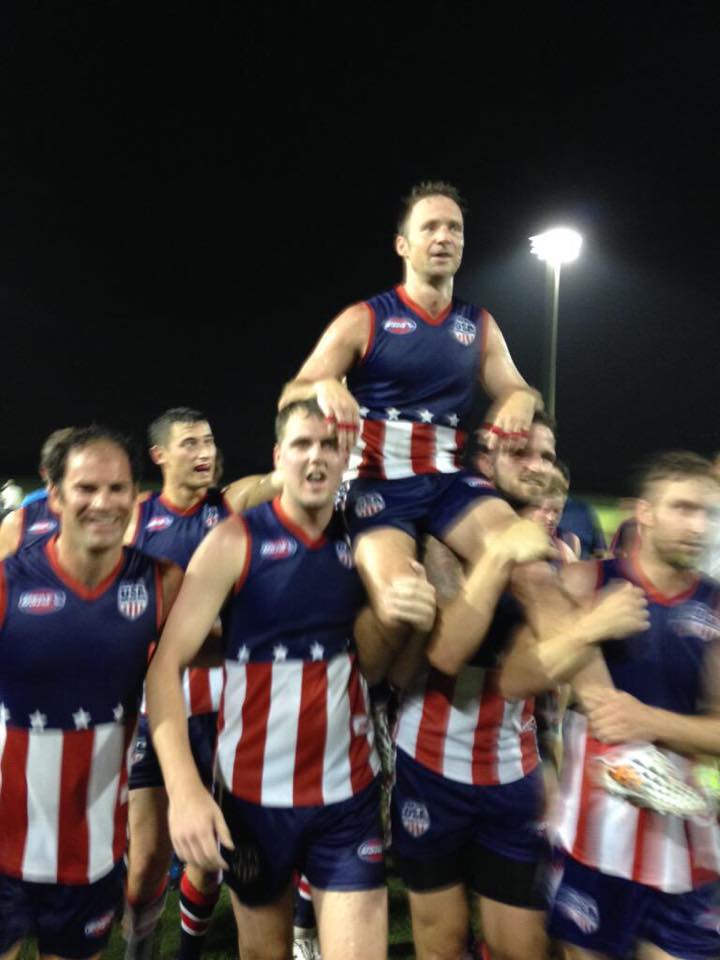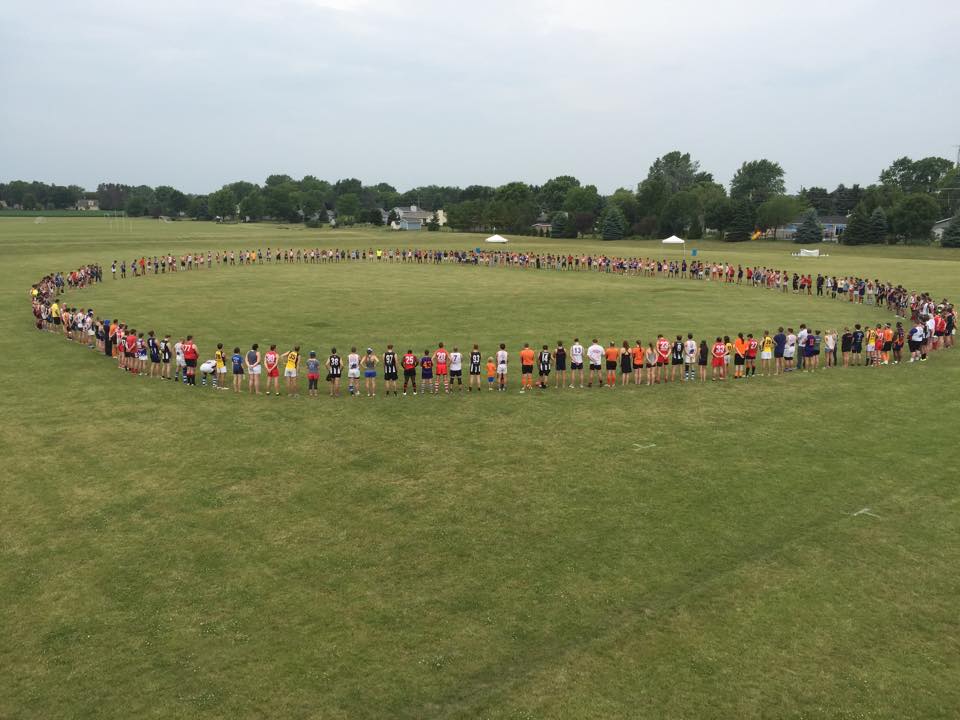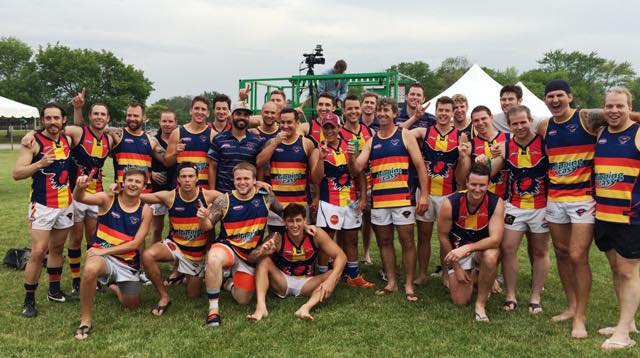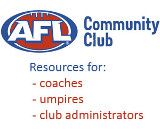That Was the Year That Was 2015
|
|
The final few pages of Anno Domini 2015 are being carefully torn off the pages of father time, though you won’t know it thanks to ol’ Mother Nature. December on the East Coast of the United States feels more like that on the East Coast of Australia, with weather more suitable for having a kick in the backyard than sitting inside doing push-ups.
Indeed, here we are. 2016, and its footy season, are coming as hard and fast as young Ben Carpenter charging through the pack on his home ground in Austin. And as another year of prepares to make its annual appearance, now would be a good time to look back and review on the year that was in American Aussie Rules.
It would not be hyperbolic to suggest that this year saw more momentum in the game here than any season in recent memory. A growing women’s program, a new era in Revo history, and the indelible stars-and-stripes footprint of the game in Australia highlighted the campaign and brought with it optimism for the future.
And so, here were the top five stories from 2015:
The Ladies Take the Fore
This year saw significant growth in women’s football in Australia, with participation at an all-time high, record shattering viewership of the AFL Women’s Series, and the formation of a national women’s league to begin play in 2017.
But Australia wasn’t the only place where growth was present. In a season where the 10th anniversary of the women’s division at Nationals was celebrated, the USAFL had its largest and most competitive competition in its history.
While numerous male players have come over to play and help USAFL clubs over the years, this year marked the beginning of the women’s player exchange program. With the help of Australian Advisory Board chairman Tony Fairhead and league women’s director Drea Casillas, 23-year-old Jessica Wuetschner became the first female AFL player to play in the USAFL, landing with the Boston Lady Demons.
Just weeks after playing for the Western Bulldogs, “Woosha” helped give the rebuilding Lady Dees side a much needed shot in the arm. The experience was mutually beneficial for both sides, and will hopefully open the door for more Aussies to come over in the years ahead.
As in Australia, participation grew just about across the board, with clubs like Arizona, Portland, and Columbus bolstering their numbers, and Tulsa, Chicago, and Houston getting their first players. By the time Nationals came around, nearly 200 women representing 13 American and 3 Canadian sides competed in two divisions for the first time in history.
On the field, the more established clubs showed marked improvement in skills, which made for great games during the regular season and playoffs. The most improved side was the New York Magpies, who had their best season under new head coach Christina Licata.
Heading into the final tournament, many people tipped the Denver Lady Bulldogs to take home their sixth consecutive National championship. This was in spite of the fact that their four fellow combatants from San Francisco, New York, Minnesota, and Sacramento had all vastly improved during the course of the regular season.
Denver won in the end, but it was not easy. After getting pushed to the limit against upstart Sacramento, it was the Minnesota Freeze who finally handed the Bulldogs their first Nationals loss since 2009, when Paige Kiecker’s free kick after the siren floated between the big sticks.
Heading into the final slate of games, four of the five teams had a chance at the D1 title. San Francisco and New York, who each etched their best season into their respective history books, would come oh so close to assuming the throne. Though Bruce Durrell and the ‘Doggies did it again, the 2015 National Championships proved that the field at the top is quite level, and 2016 may be the year a new champion arises.
Ellis Takes the Helm
 After six seasons as coach of the USA Revolution men’s national team, Matt Bishop stepped down from that role in April after compiling a 10-4 record while taking the Revos to 4th in the 2011 International Cup, and 8th in IC14.
After six seasons as coach of the USA Revolution men’s national team, Matt Bishop stepped down from that role in April after compiling a 10-4 record while taking the Revos to 4th in the 2011 International Cup, and 8th in IC14.
The man tapped to replace Bishop was a familiar face to the Revolution family, and one who has a history of winning for club and country. Tom Ellis became the first former Revo player to assume to role as gaffer of the national team. He was a part, either as player or coach, of all eight national championships won by the Denver Bulldogs. And when he took over the reins of the Revos, he had a mere two months to prepare for his first test, the 49th Parallel Cup match vs. Canada.
Ellis’ first act was to decree that his goal was to win the next International Cup, something the USA has not done since the tournament was inaugurated. In an open letter to the league, he called for clubs across the country to help with the goal by helping to identify players for the Revolution program.
“I will tell you that we can win the next International Cup in 2017,” he said, “but it will take a lot of help. From every club, coach, president, down to the newest member of each club, to make it happen. We need help and I will be reaching out to you all. We as a league have the opportunity to do something that has never been done. We will bring the cup home.”
Surrounding himself with old teammates such as Jason Becker and Dan Sarbacker on his coaching staff, Ellis and his team prepared not only for Canada, but to lay the foundation for 2017. After a successful training camp in Nashville, the Revos went to Fort Lauderdale on August 1st to face the team that finished 5th last year in Melbourne.
Led by captain Bryan Dragus, the Revos staked themselves to a large first half lead, then had to play defense as the Northwind mounted a counter attack. Luke Nemeth, Saleh Tyebjee, and veteran Andy Vanica built a brick wall in front of the goals – almost literally – and the US held on for a 45-29 victory on a hot and sticky Florida night.
That first victory is one that Ellis, and American footy fans everywhere, will look to as the beginning of the road to ultimate glory in Australia in about 20 months’ time. Ellis is building the Revos not as an all-star team, but as a club in and of itself, one that represents every American footy player who steps onto the ground across the country.
So far, so good.
Holmes Paints AFL in Star Spangled Banner
 The AFL’s US combine was created in order to harvest talent in a hitherto untapped hinterland of footy talent. Over the past five seasons, a number of suitors for the honor of being the first born-and-bred American to play at the game’s highest level.
The AFL’s US combine was created in order to harvest talent in a hitherto untapped hinterland of footy talent. Over the past five seasons, a number of suitors for the honor of being the first born-and-bred American to play at the game’s highest level.
Entering the year, there were four prospects in the wings, all playing one step below in the Victorian Football League. Chicago’s Jason Holmes (St Kilda), New York’s Alex Aurrichio (Northern Blues), Oklahoma’s Mason Cox (Collingwood), and North Carolina’s Eric Wallace (North Melbourne).
Holmes and Cox featured in their team’s NAB Cup sides during the AFL’s preseason, with the St Kilda man kicking a nice long goal on the run against Essendon. As the season went on, Holmes, Aurrichio, and Cox put up monster numbers for their clubs, and the question wasn’t if, but rather when, and who, would be the first to break through.
In the end, it would be the 25-year-old Chicagoan, who once played metro with the USAFL’s Chicago Swans, who would be anointed as the chosen one. Two years after first trying his hand at the game, and with the glaring spotlight of Etihad Stadium burning bright, Holmes would put in a solid debut. Notching 34-hit outs, he earned praise from fans and foes alike in a 97-all draw with Geelong.
Though he wouldn’t have as good of a game in the season finale the final week, there is still a great amount of optimism surrounding Holmes and the other Americans who hope to hit the big time. Cox and Aurrichio are serious candidates to be AFL debutantes in 2016, as will Arizonan Matt Korcheck, who inked a two year deal with Carlton in the offseason.
In addition to those at the top level, a number of USAFL players put in time down in Australia with local clubs. Austin’s Ben Carpenter and Portland’s Terrence Brasch spent 2015 honing their skills in country Victoria with Montrose and Dimboola, respectively. Both players returned to lead their teams to Grand Final victories at the end of the year.
Footy Community Remembers Phil Walsh
 The most shocking story of 2015 in the world of Australian Rules football was the sudden and tragic passing of Adelaide Football Club coach Phil Walsh on July 3rd. Walshy was a beloved and respected member of the footballing community, and his death stunned fans of the game far beyond the city of Adelaide.
The most shocking story of 2015 in the world of Australian Rules football was the sudden and tragic passing of Adelaide Football Club coach Phil Walsh on July 3rd. Walshy was a beloved and respected member of the footballing community, and his death stunned fans of the game far beyond the city of Adelaide.
Grief and sadness in footy, however is not a solitary thing. For the sport, and the people who play it, is a familial enterprise. It transcends team loyalties and reminds us that we are all humans, and we all feel loss in the same way. Sentiment over Walsh’s death came pouring from around Australia and beyond, as fans, players, and everyone involved with the game reached out to pay their respects.
The USAFL honored the late coach with a stirring tribute at the Central Regional Tournament in Racine, Wisconsin on July 11th. More than 400 players, coaches, and fans joined in a circle and moment of silence. The image of the tribute was seen by over 100,000 people on social media and was the most engaging social media post in league history.
Old Champions and New Reign in Austin
By the time the middle of October brought the finals back to the center of the Lone Star State, the 30-plus USAFL clubs that had participated in the season had put together one of the most competitive regular seasons in the league’s history.
It’s a long way to the top if you want to rock and roll. And the teams who took home hardware had climbed that way over the period of several years. Four of the six champions crowned in Austin had won Nationals flags previously, while the remaining two climbed the mountain for the first time. All this set across the backdrop of the largest participated field in the tournament’s two-decades existence.
 Austin’s home club, the Crows, were licking their chops at the chance to hoist their second D1 title in three seasons on home turf. But in order to do that, they had to face the gauntlet that was the most competitive field at the highest level of Nationals competition. All eight teams could conceivably be considered chances to win. But in the end, it was Kendrick Tyrell, Ben Carpenter, and the rest of the hooped murder that won the day, turning aside a strong but outmatched Orange County Bombers side on the day.
Austin’s home club, the Crows, were licking their chops at the chance to hoist their second D1 title in three seasons on home turf. But in order to do that, they had to face the gauntlet that was the most competitive field at the highest level of Nationals competition. All eight teams could conceivably be considered chances to win. But in the end, it was Kendrick Tyrell, Ben Carpenter, and the rest of the hooped murder that won the day, turning aside a strong but outmatched Orange County Bombers side on the day.
For the Bombers, however, there would be some solace on the weekend. Their reserves were paired in Division 4 with the San Diego Lions, who are still chugging along as a club despite struggling to keep up numbers during the course of the season. The combination, however, was lethal, as the SoCal side emerged victorious, topping the 12-team competition after knocking off Kansas City in the final.
This year saw the first ever expanded women’s competition, but it was Denver that ended up winning their 6th crown in a row despite that stumble against Minnesota. Down in Divvy 2, it was 2008 Premiers Calgary who ran out winners, helped by reinforcements from Portland and Vancouver.
The two first time winners saw victories achieved as fruits reaped from years of building clubs in their locales. The Quebec Saints shocked the field by running through Division 2 and blanking Sacramento in the final. The Saints, whose local competition is growing faster by the season in Le Belle Province, have a number of local stars balanced by Aussie imports.
Finally, an 18-season drought by the Portland Steelheads (nee Power) went bye-bye after Brasch, Jonathan Bornstein, and Tassie veteran Martin Coventry took over Division 3. Rose City got its first USAFL title of any variety after the Fish withstood the challenge of the Ohio Valley River Rats in the final.
Next year’s Nationals heads to the Sunshine State for the first time, as Sarasota, Florida will play host to the magical carnival of footy that we’ve come to know and love.
|
|
|






